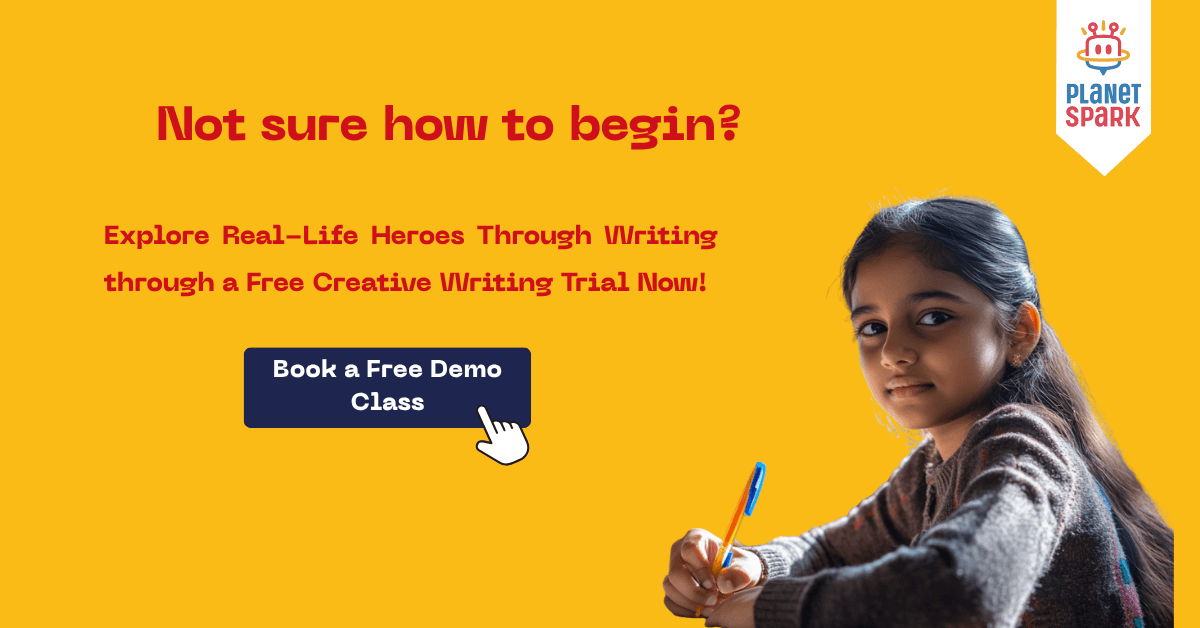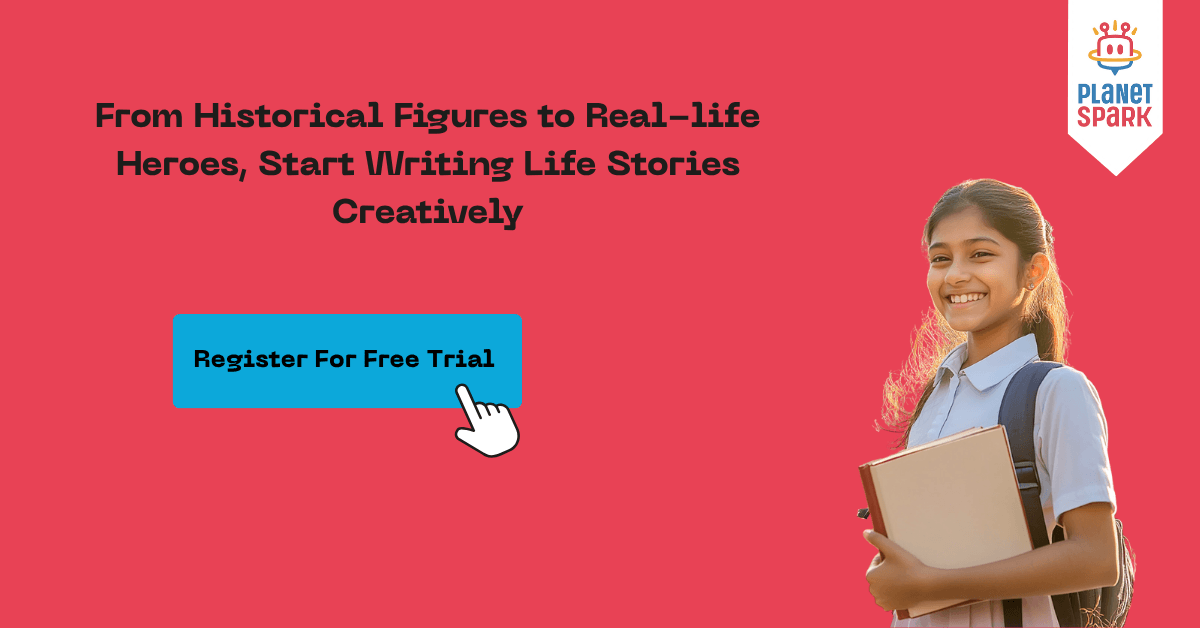Biography Writing for Class 7: Tips & Examples

Do you love reading stories about real people who changed the world? Do you get inspired by great leaders, inventors, athletes, or artists? Then you're already close to understanding what biography writing is all about.
In this blog, we’ll walk you through everything you need to know about biography writing for Class 7. We’ll also show you how PlanetSpark’s Creative Writing course can turn you into a skilled biographer.

What Is Biography Writing?
A biographical sketch is a brief synopsis of a person’s life. Any remarkable personality who has been on the top in his/ her field can be chosen as a biographee. The best Biography Writing Course for class 7 concentrates on personal histories, in order to discover and explain the influence of that individual on a world as a whole. The biographee’s strengths, weaknesses, triumphs and defeats are at the center of research. Class 7
Biography Writing development class seeks to explain the biographee as an individual as well as an influencer. The narrative can either be a simple chronological description of an individual's life, or it can be a deeply analytical one, explaining a person's actions, choices, and motivations. In the latter case, an individual's life progress would typically be explained using social, and even psychoanalytic, approaches.
Elements of a Good Biography for Class 7
When writing a biography, students should include the following:
Introduction of the Person: Start by introducing the subject. Who are they? Why are they important? When and where were they born?
Early Life and Education: Talk about the person’s childhood, education, family, and experiences that shaped their personality.
Major Life Events: Highlight key events, struggles, turning points, or breakthroughs in their career.
Achievements and Contributions: Explain what they accomplished and how they influenced the world.
Interesting Facts: Include fun or lesser-known facts that make the biography more engaging.
Conclusion and Impact: Wrap it up by summarizing the person’s legacy and how they continue to inspire others.
How to Write a Biography: Step-by-Step Guide for Class 7
Step 1: Choose a Subject
Start by selecting a person you admire or find interesting. Your subject can be:
A historical figure (e.g., Mahatma Gandhi, Rani Lakshmi Bai)
A famous personality (e.g., A.P.J. Abdul Kalam, Mary Kom)
A family member or teacher who inspires you
Tip: Pick someone whose life you feel connected to or curious about. A strong emotional interest will make your writing more genuine and engaging.
Step 2: Research the Person
Now it’s time to gather information. Research helps you understand your subject better and write accurately.
Sources to explore: Library books and encyclopedias, Documentaries and interviews, Online articles and biographies (make sure they are from trusted websites) and Talking to people (if your subject is a family member, teacher, or someone you know).
Tip: Look for information about their early life, education, key achievements, struggles, turning points, and legacy. Note down important dates, places, and events.
Step 3: Make a Timeline
A timeline is a helpful tool to organize your information in the order it happened.
Make a list like this:
1931 – Born in Tamil Nadu
1954 – Graduated from college
1980 – Contributed to space launch mission
2002 – Became President of India
Why it helps: Timelines prevent you from mixing up events and make your biography easier to follow.
Step 4: Plan the Structure
Every good biography has a clear structure. Here’s a format Class 7 students can follow:
Introduction: Briefly introduce the person who they are, why they are known, and what you admire about them.
Early Life: Talk about their family background, childhood, education, and early influences.
Major Life Events: Highlight important moments, such as struggles, achievements, awards, or key turning points.
Achievements and Contributions: Explain what they accomplished and how they impacted the world or others.
Interesting Facts: Add some fun or lesser-known details to keep your reader interested.
Conclusion: Share what you’ve learned from their life. Why do you think their story matters?
Tip: Use headings or paragraph breaks for each section so your writing stays clear and organized.
Step 5: Write the First Draft
Now that you’ve done your research and planned your structure, it’s time to start writing!
Use your own words. Avoid copying directly from books or websites.
Write in the third person (he/she/they), even if you're writing about someone you know.
Keep your sentences clear and simple. Use expressive language, but don’t make it complicated.
Use connecting words like then, after that, finally, because of this, etc., to maintain flow.
Add descriptive language where appropriate describe the person’s emotions, challenges, or surroundings.
Step 6: Edit and Improve
Once you’ve completed your first draft, it’s time to polish your writing. Even professional authors revise their work before publishing!
Here’s how to edit effectively:
Read aloud: This helps you catch awkward phrases or missing words.
Check grammar and spelling: Use a dictionary or online grammar tool.
Look for clarity: Are all events in order? Do your sentences make sense?
Ask for feedback: Show your biography to a parent, teacher, or friend. Listen to their suggestions and revise accordingly.
Format neatly: Use paragraph spacing, correct punctuation, and proper indentation.
Tip: Don’t be afraid to rewrite parts if they don’t sound right. Writing is a process, and good writers often rewrite multiple times before they’re satisfied.
Write Biographies That Inspire. Learn How at PlanetSpark’s Creative Writing Workshop.
Biography Writing: Samples
1. Marie Curie – A Pioneer in Science
Marie Curie was a brilliant scientist known for her discovery of radioactivity. She was born on November 7, 1867, in Warsaw, Poland. Despite facing financial difficulties and gender discrimination, she worked hard and moved to France to study science at the University of Paris.
Along with her husband Pierre Curie, she discovered the elements polonium and radium. She became the first woman to win a Nobel Prize and later, the first person ever to win two Nobel Prizes in different fields: Physics and Chemistry.
Marie Curie’s work changed the world of science forever and helped develop modern medical treatments. Her dedication to research and education continues to inspire students around the globe.
2. Kalpana Chawla – Reaching for the Stars
Kalpana Chawla was the first Indian-born woman to go to space. She was born in Karnal, Haryana, in 1962. From a young age, Kalpana was fascinated by airplanes and dreamed of flying.
She studied aerospace engineering in India and later moved to the United States for higher studies. In 1997, she made history by flying aboard the space shuttle Columbia. Her second mission in 2003 ended tragically when the shuttle broke apart on re-entry, killing all crew members.
Even though her life was short, Kalpana Chawla’s courage, intelligence, and determination made her a hero for millions of people. Her story inspires students to dream big and aim high.
Want your kid to become the next Walter Isaacson? Click here to learn more.
How PlanetSpark Helps in Biography Writing
At PlanetSpark, biography writing is more than just listing facts. It’s about crafting meaningful stories and expressing creatively. Here's how the Creative Writing Program supports students:
Genre-Based Curriculum: Students are exposed to different writing genres like biographies, short stories, essays, and poems. Each module focuses on structure, tone, and creativity.
Framework-Driven Instruction: Children learn techniques like the 5W1H (Who, What, When, Where, Why, How), PEEL method for paragraphs, and chronological ordering for biographies.
Real-Time Feedback and Rewriting: Students receive live feedback from expert trainers, improving their drafts through guided editing sessions.
Writing + Speaking Integration: Learners present their biographies out loud to improve articulation and confidence. This enhances memory and clarity in expression.

Frequently Asked Questions
Q. Which biography writing course is the best?
A. Biography writing isn’t an easy skill to learn. It is required to represent the life of a third person from an unbiased yet interesting angle. To develop English Biography Writing for class 7, only that course that helps your children understand the process is the best one.
Q. Which online biography writing course is the best?
A. Biography writing for class 7 can simply be termed as writing personal history and it can get complicated at times. Mentors at PlanetSpark are always one step ahead of the childrens to guide them through the process, that’s our courses are the best.
Q. What are biography writing classes?
A. Writing a biographical sketch means writing a brief summary of a person’s life, achievements and failures. The goal is always to write an interesting yet impartial sketch in third person to engage the readers. Details like special awards, interests, recognitions etc are to be included in the biography.
Q. How do I start biography writing training?
A. For writing a biography, one should have a complete understanding about the life of the biographee. Every experience that might have shaped his/ her life should be taken into consideration including achievements, failures and adventures.
Personalized Communication Report
Record a video to get a AI generated personalized communication report for your child

Hi There, want to try these
tips for your child with
LIVE with our expert coach?
Let's check your child's
English fluency
